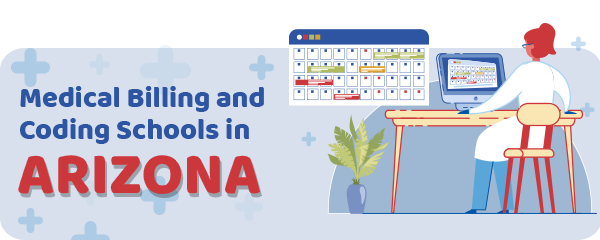The American healthcare system needs medical coding and billing specialists in order to operate smoothly.
Medical coding and billing are actually two separate functions, however, with proper training, a single person can perform them both.
Most employers will require certified personnel on this position, so if you want to learn more about being a medical coder and biller in Arizona, read on!
Article Table of Contents
What is Medical Coding?
Sometimes the information written in a medical chart is needed to collect data to compose an invoice or for other purposes.
Using a code for the various illnesses, procedures, and even medications make this process easier.
To make the process easier, a medical coder that is familiar with the following codes is generally preferred:
- CPT
- HCPCS Level II
- ICD-10-CMN
These are part of these 3 main sets of code:
- CPT,
- ICD,
- HCPCS
Arizona’s medical coders are required to know how to:
- Navigate the medical terminology in the charts
- Navigate the organization of the codes
- Use the code
All that knowledge is needed because the codes have a specific way in which they are organized and in which they’re used.
What is Medical Billing?
Without medical bills, patients can’t pay for the treatments they received and doctors and nurses can’t receive the money they deserve for their services.
It’s clear that medical billing is an important aspect of the healthcare system of the USA.
Employing specialized personnel that knows how to create an invoice is very important as they make the process much easier.
Medical billers need knowledge of:
- How the insurance system operates
- What actions affect it
- Specific terminology, related to both the medical field and financial field
Education and Certification of Medical Coders and Billers
It’s already established that without the appropriate certification, it’s nearly impossible to work in the medical coding and billing field.
The certifications most employers are looking for is the one issued by AAPC, who actually created these certifications.
There are actually 2 certifications available to those who hope to enter this field:
- CPB: For future medical billers
- CPC: For future medical coders
If you’re wondering which one to obtain, you should know that you can even obtain both of them, as many employers would prefer personnel who can do both actions.
To get certified, you first need to complete a training program that lasts for less than a year, for about 8 months.
When the training is completed, you’ll be expected to pass an exam and then receive the certification.
You can seek to obtain a degree as well if you think you’ll want to pursue a career in this domain.
Having a degree of any kind is not mandatory, thus the field of medical coding and billing is accessible to many people.
The classes are offered by both AAPC but also by other educational institutions.
| School Name | Address |
|---|---|
| Brookline College | 1140 S. Priest Drive Tempe, AZ 85281 |
| Brookline College | 5441 E. 22nd Street Suite 125 Tucson, AZ 85711 |
| Brookline College | 2445 W Dunlap Ave STE 100 Phoenix, AZ 85021 |
| Carrington College | 1001 W. Southern Ave., Suite 130 Mesa, AZ 85210 |
| Carrington College | 2149 W Dunlap Ave, Ste 103 Phoenix, AZ 85021 |
| Carrington College | 201 N Bonita Ave., Ste 101 Tucson, AZ 85745 |
| Fortis College | 555 North 18th Street, Suite 110 Phoenix, AZ 85006 |
| Phoenix College | 1202 W Thomas Rd, Phoenix, AZ 85013 |
| Pima Community College | 6680 S Country Club Rd, Tucson, AZ 85709 |
| Sanford-Brown College | 9630 N 25th Ave, Phoenix, AZ 85021 |
| Southwest Skill Center | 3000 N Dysart Rd, Avondale, AZ 85392 |
The main requirement to enroll in the training program for medical coding and billing is to have a high school diploma or a GED.
It’s also possible to attend online classes for this specialty, therefore folks who have trouble commuting can also enroll in such a training program.
No matter which school you want to enroll in, make sure it offers support when it comes to finding employment for its graduates, no matter the diploma it awards.
Expected Salary
Experience and physical location of the employer are the main factors deciding how much you’ll earn in Arizona as a medical coder and biller.
It’s also good to know that having a double certification means a higher paycheck compared to a person who can only do the coding part of the billing part.
Annual Salary Range:
Location
Avg. Annual Salary
Phoenix
$37,958
Tucson
$35,994
Mesa
$37,235
Chandler
$37,235
Scottsdale
$37,235
Glendale
$37,958
Gilbert
$37,235
Tempe
$37,235
Peoria
$37,882
Surprise
$37,361
Regional Salary in Arizona
Region
Employed
Avg. Annual Salary
Avg. Hourly Pay
Top 10% Annual Salary
Bottom 10% Annual Salary
Flagstaff, AZ 80 $54,230 $26.07 $77,440 $40,310 Lake Havasu City-Kingman, AZ 80 $48,500 $23.32 $65,430 $32,520 Phoenix-Mesa-Scottsdale, AZ 2,420 $50,280 $24.18 $64,530 $36,990 Prescott, AZ 100 $51,960 $24.98 $75,560 $36,590 Sierra Vista-Douglas, AZ 50 $47,830 $22.99 $63,070 $34,970 Tucson, AZ 500 $49,150 $23.63 $67,700 $35,550 Yuma, AZ 90 $51,600 $24.81 $68,600 $33,070
* Employment conditions in your area may vary.
Where to Find Employment
The largest employers for medical coders and billers in Arizona are:
- Banner Baywood Medical Center
- Banner Behavioral
- Banner Heart
When applying for a job, ask about the possibility of working from home, as this field offers this option.
Read the full guide: How to Become a Medical Biller and Coder
